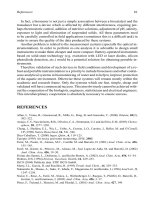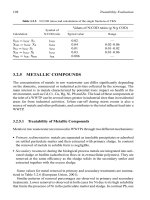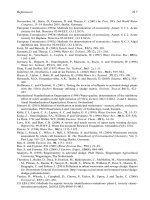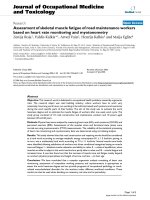Process or Product Monitoring and Control_15 doc
Bạn đang xem bản rút gọn của tài liệu. Xem và tải ngay bản đầy đủ của tài liệu tại đây (1.12 MB, 17 trang )
0.1000E-09
MAXIMUM SCALED RELATIVE CHANGE IN THE PARAMETERS (STOPP)
0.1489E-07
MAXIMUM CHANGE ALLOWED IN THE PARAMETERS AT FIRST ITERATION (DELTA)
100.0
RESIDUAL SUM OF SQUARES FOR INPUT PARAMETER VALUES
138.7
(BACKFORECASTS INCLUDED)
RESIDUAL STANDARD DEVIATION FOR INPUT PARAMETER VALUES (RSD)
0.4999
BASED ON DEGREES OF FREEDOM 559 - 1 - 3 = 555
NONDEFAULT VALUES
AFCTOL V(31) = 0.2225074-307
##### RESIDUAL SUM OF SQUARES CONVERGENCE #####
ESTIMATES FROM LEAST SQUARES FIT (* FOR FIXED PARAMETER)
########################################################
PARAMETER STD DEV OF ###PAR/
##################APPROXIMATE
ESTIMATES ####PARAMETER ####(SD 95 PERCENT
CONFIDENCE LIMITS
TYPE ORD ###(OF PAR) ####ESTIMATES ##(PAR) #######LOWER
######UPPER
FACTOR 1
AR 1 -0.40604575E+00 0.41885445E-01 -9.69 -0.47505616E+00
-0.33703534E+00
AR 2 -0.16414479E+00 0.41836922E-01 -3.92 -0.23307525E+00
-0.95214321E-01
MU ## -0.52091780E-02 0.11972592E-01 -0.44 -0.24935207E-01
0.14516851E-01
NUMBER OF OBSERVATIONS (N) 559
RESIDUAL SUM OF SQUARES 109.2642
(BACKFORECASTS INCLUDED)
RESIDUAL STANDARD DEVIATION 0.4437031
BASED ON DEGREES OF FREEDOM 559 - 1 - 3 = 555
APPROXIMATE CONDITION NUMBER 3.498456
6.6.2.3. Model Estimation
(2 of 5) [5/1/2006 10:35:56 AM]
Interpretation
of Output
The first section of the output identifies the model and shows the starting values for the fit.
This output is primarily useful for verifying that the model and starting values were
correctly entered.
The section labeled "ESTIMATES FROM LEAST SQUARES FIT" gives the parameter
estimates, standard errors from the estimates, and 95% confidence limits for the
parameters. A confidence interval that contains zero indicates that the parameter is not
statistically significant and could probably be dropped from the model.
The model for the differenced data, Y
t
, is an AR(2) model:
with
0.44
.
It is often more convenient to express the model in terms of the original data, X
t
, rather
than the differenced data. From the definition of the difference, Y
t
= X
t
- X
t-1
, we can make
the appropriate substitutions into the above equation:
to arrive at the model in terms of the original series:
Dataplot
ARMA
Output for
the MA(1)
Model
Alternatively, based on the differenced data Dataplot generated the following estimation
output for an MA(1) model:
#############################################################
# NONLINEAR LEAST SQUARES ESTIMATION FOR THE PARAMETERS OF #
# AN ARIMA MODEL USING BACKFORECASTS #
#############################################################
SUMMARY OF INITIAL CONDITIONS
MODEL SPECIFICATION
FACTOR (P D Q) S
1 0 1 1 1
DEFAULT SCALING USED FOR ALL PARAMETERS.
##STEP SIZE
FOR
######PARAMETER
##APPROXIMATING
#################PARAMETER DESCRIPTION STARTING VALUES
#####DERIVATIVE
INDEX #########TYPE ##ORDER ##FIXED ##########(PAR)
6.6.2.3. Model Estimation
(3 of 5) [5/1/2006 10:35:56 AM]
##########(STP)
1 MU ### NO 0.00000000E+00
0.20630657E-05
2 MA (FACTOR 1) 1 NO 0.10000000E+00
0.34498203E-07
NUMBER OF OBSERVATIONS (N) 559
MAXIMUM NUMBER OF ITERATIONS ALLOWED (MIT)
500
MAXIMUM NUMBER OF MODEL SUBROUTINE CALLS ALLOWED
1000
CONVERGENCE CRITERION FOR TEST BASED ON THE
FORECASTED RELATIVE CHANGE IN RESIDUAL SUM OF SQUARES (STOPSS)
0.1000E-09
MAXIMUM SCALED RELATIVE CHANGE IN THE PARAMETERS (STOPP)
0.1489E-07
MAXIMUM CHANGE ALLOWED IN THE PARAMETERS AT FIRST ITERATION (DELTA)
100.0
RESIDUAL SUM OF SQUARES FOR INPUT PARAMETER VALUES
120.0
(BACKFORECASTS INCLUDED)
RESIDUAL STANDARD DEVIATION FOR INPUT PARAMETER VALUES (RSD)
0.4645
BASED ON DEGREES OF FREEDOM 559 - 1 - 2 = 556
NONDEFAULT VALUES
AFCTOL V(31) = 0.2225074-307
##### RESIDUAL SUM OF SQUARES CONVERGENCE #####
ESTIMATES FROM LEAST SQUARES FIT (* FOR FIXED PARAMETER)
########################################################
PARAMETER STD DEV OF ###PAR/
##################APPROXIMATE
ESTIMATES ####PARAMETER ####(SD 95 PERCENT
CONFIDENCE LIMITS
TYPE ORD ###(OF PAR) ####ESTIMATES ##(PAR) #######LOWER
######UPPER
FACTOR 1
MU ## -0.51160754E-02 0.11431230E-01 -0.45 -0.23950101E-01
0.13717950E-01
MA 1 0.39275694E+00 0.39028474E-01 10.06 0.32845386E+00
0.45706001E+00
NUMBER OF OBSERVATIONS (N) 559
RESIDUAL SUM OF SQUARES 109.6880
(BACKFORECASTS INCLUDED)
RESIDUAL STANDARD DEVIATION 0.4441628
BASED ON DEGREES OF FREEDOM 559 - 1 - 2 = 556
APPROXIMATE CONDITION NUMBER 3.414207
6.6.2.3. Model Estimation
(4 of 5) [5/1/2006 10:35:56 AM]
Interpretation
of the Output
The model for the differenced data, Y
t
, is an ARIMA(0,1,1) model:
with
0.44
.
It is often more convenient to express the model in terms of the
original data, X
t
, rather than the differenced data. Making the
appropriate substitutions into the above equation:
we arrive at the model in terms of the original series:
6.6.2.3. Model Estimation
(5 of 5) [5/1/2006 10:35:56 AM]
6. Process or Product Monitoring and Control
6.6. Case Studies in Process Monitoring
6.6.2. Aerosol Particle Size
6.6.2.4.Model Validation
Residuals After fitting the model, we should check whether the model is appropriate.
As with standard non-linear least squares fitting, the primary tool for model
diagnostic checking is residual analysis.
4-Plot of
Residuals from
ARIMA(2,1,0)
Model
The 4-plot is a convenient graphical technique for model validation in that it
tests the assumptions for the residuals on a single graph.
6.6.2.4. Model Validation
(1 of 6) [5/1/2006 10:35:57 AM]
Interpretation
of the 4-Plot
We can make the following conclusions based on the above 4-plot.
The run sequence plot shows that the residuals do not violate the
assumption of constant location and scale. It also shows that most of
the residuals are in the range (-1, 1).
1.
The lag plot indicates that the residuals are not autocorrelated at lag 1.2.
The histogram and normal probability plot indicate that the normal
distribution provides an adequate fit for this model.
3.
Autocorrelation
Plot of
Residuals from
ARIMA(2,1,0)
Model
In addition, the autocorrelation plot of the residuals from the ARIMA(2,1,0)
model was generated.
Interpretation
of the
Autocorrelation
Plot
The autocorrelation plot shows that for the first 25 lags, all sample
autocorrelations expect those at lags 7 and 18 fall inside the 95% confidence
bounds indicating the residuals appear to be random.
6.6.2.4. Model Validation
(2 of 6) [5/1/2006 10:35:57 AM]
Ljung-Box Test
for
Randomness
for the
ARIMA(2,1,0)
Model
Instead of checking the autocorrelation of the residuals, portmanteau tests
such as the test proposed by Ljung and Box (1978) can be used. In this
example, the test of Ljung and Box indicates that the residuals are random at
the 95% confidence level and thus the model is appropriate. Dataplot
generated the following output for the Ljung-Box test.
LJUNG-BOX TEST FOR RANDOMNESS
1. STATISTICS:
NUMBER OF OBSERVATIONS = 559
LAG TESTED = 24
LAG 1 AUTOCORRELATION = -0.1012441E-02
LAG 2 AUTOCORRELATION = 0.6160716E-02
LAG 3 AUTOCORRELATION = 0.5182213E-02
LJUNG-BOX TEST STATISTIC = 31.91066
2. PERCENT POINTS OF THE REFERENCE CHI-SQUARE DISTRIBUTION
(REJECT HYPOTHESIS OF RANDOMNESS IF TEST STATISTIC VALUE
IS GREATER THAN PERCENT POINT VALUE)
FOR LJUNG-BOX TEST STATISTIC
0 % POINT = 0.
50 % POINT = 23.33673
75 % POINT = 28.24115
90 % POINT = 33.19624
95 % POINT = 36.41503
99 % POINT = 42.97982
3. CONCLUSION (AT THE 5% LEVEL):
THE DATA ARE RANDOM.
4-Plot of
Residuals from
ARIMA(0,1,1)
Model
The 4-plot is a convenient graphical technique for model validation in that it
tests the assumptions for the residuals on a single graph.
6.6.2.4. Model Validation
(3 of 6) [5/1/2006 10:35:57 AM]
Interpretation
of the 4-Plot
from the
ARIMA(0,1,1)
Model
We can make the following conclusions based on the above 4-plot.
The run sequence plot shows that the residuals do not violate the
assumption of constant location and scale. It also shows that most of
the residuals are in the range (-1, 1).
1.
The lag plot indicates that the residuals are not autocorrelated at lag 1.2.
The histogram and normal probability plot indicate that the normal
distribution provides an adequate fit for this model.
3.
This 4-plot of the residuals indicates that the fitted model is an adequate
model for these data.
Autocorrelation
Plot of
Residuals from
ARIMA(0,1,1)
Model
The autocorrelation plot of the residuals from ARIMA(0,1,1) was generated.
6.6.2.4. Model Validation
(4 of 6) [5/1/2006 10:35:57 AM]
Interpretation
of the
Autocorrelation
Plot
Similar to the result for the ARIMA(2,1,0) model, it shows that for the first
25 lags, all sample autocorrelations expect those at lags 7 and 18 fall inside
the 95% confidence bounds indicating the residuals appear to be random.
Ljung-Box Test
for
Randomness of
the Residuals
for the
ARIMA(0,1,1)
Model
The Ljung and Box test is also applied to the residuals from the
ARIMA(0,1,1) model. The test indicates that the residuals are random at the
99% confidence level, but not at the 95% level.
Dataplot generated the following output for the Ljung-Box test.
LJUNG-BOX TEST FOR RANDOMNESS
1. STATISTICS:
NUMBER OF OBSERVATIONS = 559
LAG TESTED = 24
LAG 1 AUTOCORRELATION = -0.1280136E-01
LAG 2 AUTOCORRELATION = -0.3764571E-02
LAG 3 AUTOCORRELATION = 0.7015200E-01
LJUNG-BOX TEST STATISTIC = 38.76418
2. PERCENT POINTS OF THE REFERENCE CHI-SQUARE DISTRIBUTION
(REJECT HYPOTHESIS OF RANDOMNESS IF TEST STATISTIC VALUE
IS GREATER THAN PERCENT POINT VALUE)
FOR LJUNG-BOX TEST STATISTIC
0 % POINT = 0.
50 % POINT = 23.33673
75 % POINT = 28.24115
90 % POINT = 33.19624
95 % POINT = 36.41503
6.6.2.4. Model Validation
(5 of 6) [5/1/2006 10:35:57 AM]
99 % POINT = 42.97982
3. CONCLUSION (AT THE 5% LEVEL):
THE DATA ARE NOT RANDOM.
Summary Overall, the ARIMA(0,1,1) is an adequate model. However, the
ARIMA(2,1,0) is a little better than the ARIMA(0,1,1).
6.6.2.4. Model Validation
(6 of 6) [5/1/2006 10:35:57 AM]
6. Process or Product Monitoring and Control
6.6. Case Studies in Process Monitoring
6.6.2. Aerosol Particle Size
6.6.2.5.Work This Example Yourself
View
Dataplot
Macro for
this Case
Study
This page allows you to repeat the analysis outlined in the case study
description on the previous page using Dataplot . It is required that you
have already downloaded and installed Dataplot and configured your
browser. to run Dataplot. Output from each analysis step below will be
displayed in one or more of the Dataplot windows. The four main
windows are the Output Window, the Graphics window, the Command
History window, and the data sheet window. Across the top of the main
windows there are menus for executing Dataplot commands. Across the
bottom is a command entry window where commands can be typed in.
Data Analysis Steps Results and Conclusions
Click on the links below to start Dataplot and run this
case study yourself. Each step may use results from
previous steps, so please be patient. Wait until the
software verifies that the current step is complete before
clicking on the next step.
The links in this column will connect you with more detailed
information about each analysis step from the case study
description.
1. Invoke Dataplot and read data.
1. Read in the data. 1. You have read one column of numbers
into Dataplot, variable Y.
2. Model identification plots
1. Run sequence plot of Y.
2. Autocorrelation plot of Y.
3. Run sequence plot of the
differenced data of Y.
1. The run sequence plot shows that the
data show strong and positive
autocorrelation.
2. The autocorrelation plot indicates
significant autocorrelation
and that the data are not
stationary.
3. The run sequence plot shows that the
6.6.2.5. Work This Example Yourself
(1 of 3) [5/1/2006 10:35:57 AM]
4. Autocorrelation plot of the
differenced data of Y.
5. Partial autocorrelation plot
of the differenced data of Y.
differenced data appear to be stationary
and do not exhibit seasonality.
4. The autocorrelation plot of the
differenced data suggests an
ARIMA(0,1,1) model may be
appropriate.
5. The partial autocorrelation plot
suggests an ARIMA(2,1,0) model may
be appropriate.
3. Estimate the model.
1. ARIMA(2,1,0) fit of Y.
2. ARIMA(0,1,1) fit of Y.
1. The ARMA fit generates parameter
estimates for the ARIMA(2,1,0)
model.
2. The ARMA fit generates parameter
estimates for the ARIMA(0,1,1)
model.
4. Model validation.
1. Generate a 4-plot of the
residuals from the ARIMA(2,1,0)
model.
2. Generate an autocorrelation plot
of the residuals from the
ARIMA(2,1,0) model.
3. Perform a Ljung-Box test of
randomness for the residuals from
the ARIMA(2,1,0) model.
4. Generate a 4-plot of the
residuals from the ARIMA(0,1,1)
model.
1. The 4-plot shows that the
assumptions for the residuals
are satisfied.
2. The autocorrelation plot of the
residuals indicates that the
residuals are random.
3. The Ljung-Box test indicates
that the residuals are
random.
4. The 4-plot shows that the
assumptions for the residuals
are satisfied.
6.6.2.5. Work This Example Yourself
(2 of 3) [5/1/2006 10:35:57 AM]
5. Generate an autocorrelation plot
of the residuals from the
ARIMA(0,1,1) model.
6. Perform a Ljung-Box test of
randomness for the residuals from
the ARIMA(0,1,1) model.
5. The autocorrelation plot of the
residuals indicates that the
residuals are random.
6. The Ljung-Box test indicates
that the residuals are not
random at the 95% level, but
are random at the 99% level.
6.6.2.5. Work This Example Yourself
(3 of 3) [5/1/2006 10:35:57 AM]
6. Process or Product Monitoring and Control
6.7.References
Selected References
Time Series Analysis
Abraham, B. and Ledolter, J. (1983). Statistical Methods for Forecasting, Wiley, New
York, NY.
Box, G. E. P., Jenkins, G. M., and Reinsel, G. C. (1994). Time Series Analysis,
Forecasting and Control, 3rd ed. Prentice Hall, Englewood Clifs, NJ.
Box, G. E. P. and McGregor, J. F. (1974). "The Analysis of Closed-Loop Dynamic
Stochastic Systems", Technometrics, Vol. 16-3.
Brockwell, Peter J. and Davis, Richard A. (1987). Time Series: Theory and Methods,
Springer-Verlang.
Brockwell, Peter J. and Davis, Richard A. (2002). Introduction to Time Series and
Forecasting, 2nd. ed., Springer-Verlang.
Chatfield, C. (1996). The Analysis of Time Series, 5th ed., Chapman & Hall, New York,
NY.
DeLurgio, S. A. (1998). Forecasting Principles and Applications, Irwin McGraw-Hill,
Boston, MA.
Ljung, G. and Box, G. (1978). "On a Measure of Lack of Fit in Time Series Models",
Biometrika, 67, 297-303.
Nelson, C. R. (1973). Applied Time Series Analysis for Managerial Forecasting,
Holden-Day, Boca-Raton, FL.
Makradakis, S., Wheelwright, S. C. and McGhee, V. E. (1983). Forecasting: Methods
and Applications, 2nd ed., Wiley, New York, NY.
Statistical Process and Quality Control
6.7. References
(1 of 3) [5/1/2006 10:35:57 AM]
Army Chemical Corps (1953). Master Sampling Plans for Single, Duplicate, Double and
Multiple Sampling, Manual No. 2.
Bissell, A. F. (1990). "How Reliable is Your Capability Index?", Applied Statistics, 39,
331-340.
Champ, C.W., and Woodall, W.H. (1987). "Exact Results for Shewhart Control Charts
with Supplementary Runs Rules", Technometrics, 29, 393-399.
Duncan, A. J. (1986). Quality Control and Industrial Statistics, 5th ed., Irwin,
Homewood, IL.
Hotelling, H. (1947). Multivariate Quality Control. In C. Eisenhart, M. W. Hastay, and
W. A. Wallis, eds. Techniques of Statistical Analysis. New York: McGraw-Hill.
Juran, J. M. (1997). "Early SQC: A Historical Supplement", Quality Progress, 30(9)
73-81.
Montgomery, D. C. (2000). Introduction to Statistical Quality Control, 4th ed., Wiley,
New York, NY.
Kotz, S. and Johnson, N. L. (1992). Process Capability Indices, Chapman & Hall,
London.
Lowry, C. A., Woodall, W. H., Champ, C. W., and Rigdon, S. E. (1992). "A Multivariate
Exponentially Weighted Moving Average Chart", Technometrics, 34, 46-53.
Lucas, J. M. and Saccucci, M. S. (1990). "Exponentially weighted moving average
control schemes: Properties and enhancements", Technometrics 32, 1-29.
Ott, E. R. and Schilling, E. G. (1990). Process Quality Control, 2nd ed., McGraw-Hill,
New York, NY.
Quesenberry, C. P. (1993). "The effect of sample size on estimated limits for
and X
control charts", Journal of Quality Technology, 25(4) 237-247.
Ryan, T.P. (2000). Statistical Methods for Quality Improvement, 2nd ed., Wiley, New
York, NY.
Ryan, T. P. and Schwertman, N. C. (1997). "Optimal limits for attributes control charts",
Journal of Quality Technology, 29 (1), 86-98.
Schilling, E. G. (1982). Acceptance Sampling in Quality Control, Marcel Dekker, New
York, NY.
Tracy, N. D., Young, J. C. and Mason, R. L. (1992). "Multivariate Control Charts for
Individual Observations", Journal of Quality Technology, 24(2), 88-95.
Woodall, W. H. (1997). "Control Charting Based on Attribute Data: Bibliography and
Review", Journal of Quality Technology, 29, 172-183.
6.7. References
(2 of 3) [5/1/2006 10:35:57 AM]
Woodall, W. H., and Adams, B. M. (1993); "The Statistical Design of CUSUM Charts",
Quality Engineering, 5(4), 559-570.
Zhang, Stenback, and Wardrop (1990). "Interval Estimation of the Process Capability
Index", Communications in Statistics: Theory and Methods, 19(21), 4455-4470.
Statistical Analysis
Anderson, T. W. (1984). Introduction to Multivariate Statistical Analysis, 2nd ed., Wiley
New York, NY.
Johnson, R. A. and Wichern, D. W. (1998). Applied Multivariate Statistical Analysis,
Fourth Ed., Prentice Hall, Upper Saddle River, NJ.
6.7. References
(3 of 3) [5/1/2006 10:35:57 AM]
National Institute of Standards and Technology
(3 of 3) [5/1/2006 10:36:01 AM]









